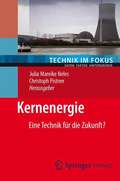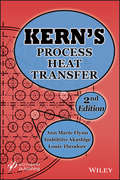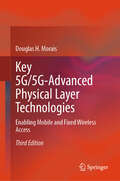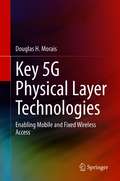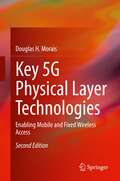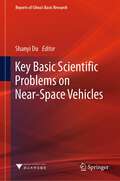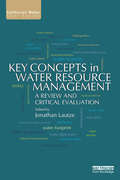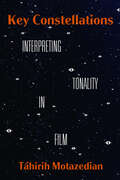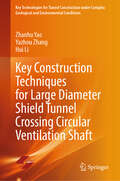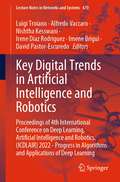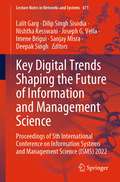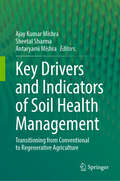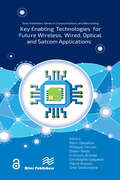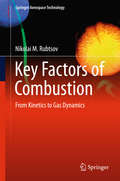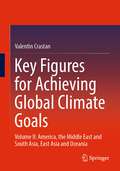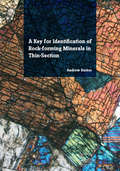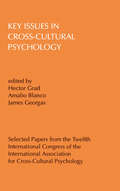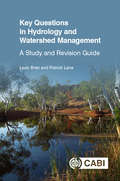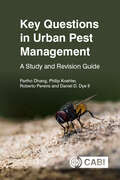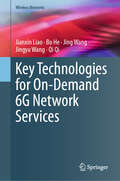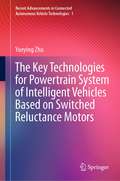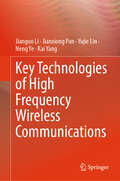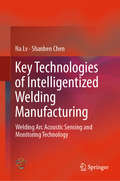- Table View
- List View
Kernenergie
by Julia Neles Christoph PistnerKnapp und klar arbeitet der Autor die Grundlagen zum Verständnis der Kernenergie heraus und ermöglicht Lesern damit einen leichten Einstieg ins Thema. Dabei vermittelt er nicht nur die technisch-wissenschaftlichen Grundlagen in allgemein verständlicher und umfassender Weise, sondern befasst sich auch mit den gesellschaftspolitischen Fragen der Sicherheit, der Entsorgung und der nuklearen Abrüstung. Der Band bietet die Möglichkeit, die aktuellen Entwicklungen nach der Reaktorkatastrophe in Fukushima einzuordnen und zu reflektieren.
Kern's Process Heat Transfer
by Ann Marie Flynn Toshihiro Akashige Louis TheodoreThis book insures the legacy of the original 1950 classic, Process Heat Transfer, by Donald Q. Kern. This second edition book is divided into three parts: Fundamental Principles; Heat Exchangers; and Other Heat Transfer Equipment/ Considerations. - Part I provides a series of chapters concerned with introductory topics that are required when solving heat transfer problems. This part of the book deals with topics such as steady-state heat conduction, unsteady-state conduction, forced convection, free convection, and radiation. - Part II is considered by the authors to be the “meat” of the book – addressing heat transfer equipment design procedures and applications. In addition to providing a more meaningful treatment of the various types of heat exchangers, this part also examines the impact of entropy calculations on exchanger design. - Part III of the book examines other related topics of interest, including boiling and condensation, refrigeration and cryogenics, boilers, cooling towers and quenchers, batch and unsteady-state processes, health & safety and the accompanying topic of risk. An Appendix is also included. What is new in the 2nd edition Changes that are addressed in the 2nd edition so that Kern’s original work continues to remain relevant in 21st century process engineering include:- Updated Heat Exchanger Design- Increased Number of Illustrative Examples- Energy Conservation/ Entropy Considerations- Environmental Considerations- Health & Safety- Risk Assessment- Refrigeration and Cryogenics- Inclusion of SI Units
Key 5G/5G-Advanced Physical Layer Technologies: Enabling Mobile and Fixed Wireless Access
by Douglas H. MoraisThis third edition of this text covers the key technologies associated with the physical transmission of data on 5G mobile systems. Following an updated overview of these technologies, the author provides a high-level description of 3GPP’s mobile communications standard (5G/5G-Advanced) and shows how the key technologies presented earlier facilitate the transmission of very high-speed user data and control data and can provide very low latency for use cases where this is important. In the final chapter, an updated overview and the physical layer aspects of 5G NR enabled Fixed Wireless Access (FWA) networks is presented. Material in the second edition addressed mainly the key physical layer technologies and features associated with 3GPP Release 15, the first release to support 5G, and Release 16. This edition adds descriptions of some of the technological advancements supported in Releases 17 and 18, the latter being designated by 3GPP as 5G-Advanced. In addition to numerous enhancements of existing features, these releases include new features such as support for 1024-QAM in the downlink in the FR1 band, Reduced Capability (RedCAP) devices, Network Controlled repeaters, operation in the 6 GHz band and above 52.6 GHz, support for broadcast/multicast services, and Non-terrestrial Networks (NTNs). Additionally, a look ahead at some of the planned features and enhancements of Release 19 is provided. This textbook is intended for graduate and upper undergraduate engineering students and practicing engineers and technicians who have an interest in 3GPP’s 5G enabled mobile and or FWA networks and want to acquire, where missing, the necessary technology background in order to understand 3GPP’s physical layer specifications and operation. Provided are working problems and helpful examples throughout the text.
Key 5G Physical Layer Technologies: Enabling Mobile and Fixed Wireless Access
by Douglas H. MoraisThis book covers the key technologies associated with the physical transmission of data on fifth generation (5G) mobile systems. Following an overview of these technologies, a high-level description of 3GPP’s mobile communications standard (5G NR) is given and it is shown how the key technologies presented earlier facilitate the transmission of control data and very high-speed user data. In the final chapter, an overview and the physical layer aspects of 5G NR enabled Fixed Wireless Access (FWA) networks is presented. This book is intended for those practicing engineers and graduate and upper undergraduate engineering students who have an interest in 3GPP’s 5G enabled mobile and or FWA networks and want to acquire, where missing, the necessary technology background in order to understand 3GPP’s physical layer specifications and operation.Provides a comprehensive covering of key 3GPP 5G NR physical layer technologies, presented in a clear, tractable fashion, with sufficient mathematics to make it technically coherent;Addresses all key 5G NR technologies, including digital modulation, LDPC and Polar coding, multicarrier based multiple access techniques, and multiple antenna techniques including MIMO and beamforming;Presents an overview of 5G NR Radio Access Network (RAN) architecture and a detailed understanding of how user and control data is transported in the physical layer by the application of the technologies presented;Provides an overview and addresses physical layer aspects of 5G NR enabled Fixed Wireless Access networks.
Key 5G Physical Layer Technologies: Enabling Mobile and Fixed Wireless Access
by Douglas H. Morais This updated book, reconfigured as a textbook, covers the key technologies associated with the physical transmission of data on 5G mobile systems. Following an updated overview of these technologies, the author provides a high-level description of 3GPP’s mobile communications standard (5G NR) and shows how the key technologies presented earlier facilitate the transmission of very high-speed user data and control data and can provide very low latency for use cases where this is important. In the final chapter, an overview and the physical layer aspects of 5G NR enabled Fixed Wireless Access (FWA) networks is presented. Material in the first edition addressed mainly the key physical layer technologies and features associated with 3GPP release 15, the first release to support 5G. This edition adds descriptions of some of the technological advancements supported in release 16, including integrated access and backhaul (IAB), sidelink communication, NR positioning, operation in unlicensed bands, and multiple transmission points transmission. This textbook is intended for graduate and upper undergraduate engineering students and practicing engineers who have an interest in 3GPP’s 5G enabled mobile and or FWA networks and want to acquire, where missing, the necessary technology background in order to understand 3GPP’s physical layer specifications and operation. The author provides working problems and helpful examples throughout the text.
Key Basic Scientific Problems on Near-Space Vehicles (Reports of China’s Basic Research)
by Shanyi DuThis book mainly introduces the research overview, research results, and follow-up prospects of “Key Basic Scientific Problems on Near-Space Vehicles”, a major research plan of National Natural Science Foundation of China (hereinafter referred to as the Plan). The Plan is the first systematic basic hypersonic research program in China. From its inception in 2007 to its successful completion in 2016, the Plan lasted nine years, funded a total of 173 projects, and the funding totaled 190 million yuan. From the perspective of major national needs and scientific discipline development, the book focuses on four key scientific issues: aerodynamics in a near-space flight environment; advanced propulsion theories and methods; ultralight materials/structures, thermal environment prediction and thermal protection; and intelligent autonomous control theories and methods for hypersonic vehicles. The book also demonstrates China’s systematic and innovative achievements in interdisciplinary theories and methods and innovative techniques, paving the way for a distinctively Chinese basic research framework and further breakthroughs of near-space hypersonic vehicles.
Key Concepts in Water Resource Management: A Review and Critical Evaluation (Earthscan Water Text)
by Jonathan LautzeThe vocabulary and discourse of water resource management have expanded vastly in recent years to include an array of new concepts and terminology, such as water security, water productivity, virtual water and water governance. While the new conceptual lenses may generate insights that improve responses to the world’s water challenges, their practical use is often encumbered by ambiguity and confusion. This book applies critical scrutiny to a prominent set of new but widely used terms, in order to clarify their meanings and improve the basis on which we identify and tackle the world’s water challenges. More specifically, the book takes stock of what several of the more prominent new terms mean, reviews variation in interpretation, explores how they are measured, and discusses their respective added value. It makes many implicit differences between terms explicit and aids understanding and use of these terms by both students and professionals. At the same time, it does not ignore the legitimately contested nature of some concepts. Further, the book enables greater precision on the interpretational options for the various terms, and for the value that they add to water policy and its implementation.
Key Constellations: Interpreting Tonality in Film (California Studies in Music, Sound, and Media #4)
by Táhirih MotazedianKey is one of the simplest building blocks of music and is among the foundational properties of a work’s musical identity—so why isn’t it a standard parameter in discussing film music? Key Constellations: Interpreting Tonality in Film is the first book to investigate film soundtracks—including original scoring, preexisting music, and sound effects—through the lens of large-scale tonality. Exploring compelling analytical examples from numerous popular films, Táhirih Motazedian shows how key and pitch analysis of film music can reveal hidden layers of narrative meaning, giving readers exciting new ways to engage with their favorite films and soundtracks.
Key Construction Techniques for Large Diameter Shield Tunnel Crossing Circular Ventilation Shaft (Key Technologies for Tunnel Construction under Complex Geological and Environmental Conditions)
by Hui Li Zhanhu Yao Yazhou ZhangBased on the construction of Nanjing Weisan Road Yangtze River Tunnel, this book comprehensively introduces the new technology of large-diameter shield tunnel construction crossing circular air shafts. It focuses on four aspects: the construction technology of super-deep circular air shaft foundation pit retaining structure in the sensitive environment near the river, underwater excavation and underwater massive concrete sealing bottom construction technology, adaptive improvement of TBM and construction technology of crossing air shaft, and control technology of super-deep foundation pit stability during the process of conversion. This book combines theory with practice, and can provide reference for shield engineering construction. It can also be used as a reference for engineering and technical personnel, researchers, teachers and students in related majors in colleges who are engaged in shield tunnel engineering.
Key Digital Trends in Artificial Intelligence and Robotics: Proceedings of 4th International Conference on Deep Learning, Artificial Intelligence and Robotics, (ICDLAIR) 2022 - Progress in Algorithms and Applications of Deep Learning (Lecture Notes in Networks and Systems #670)
by Luigi Troiano Alfredo Vaccaro Nishtha Kesswani Irene Díaz Rodriguez Imene Brigui David Pastor-EscuredoThe book (proceedings of the 4th International Conference on Deep Learning, Artificial Intelligence and Robotics (ICDLAIR) 2022) introduces key topics from artificial intelligence algorithms and programming organisations and explains how they contribute to health care, manufacturing, law, finance, retail, real estate, accountancy, digital marketing, and various other fields. Although artificial intelligence (AI) has generated a lot of hype over the past ten years, these consequences on how we live, work, and play are still in their infancy and will likely have a significant impact in the future. The supremacy of AI in areas like speech and picture recognition, navigational apps, personal assistants for smartphones, ride-sharing apps, and many other areas is already well established. The book is primarily meant for academics, researchers, and engineers who want to employ AI applications to address real-world issues. The authors hope that businesses and technology creators will also find it appealing to utilise in industry.
Key Digital Trends Shaping the Future of Information and Management Science: Proceedings of 5th International Conference on Information Systems and Management Science (ISMS) 2022 (Lecture Notes in Networks and Systems #671)
by Lalit Garg Dilip Singh Sisodia Nishtha Kesswani Joseph G. Vella Imene Brigui Sanjay Misra Deepak SinghThis book (proceedings of ISMS 2022) is intended to be used as a reference by students and researchers who collect scientific and technical contributions with respect to models, tools, technologies and applications in the field of information systems and management science. This textbook shows how to exploit information systems in a technology-rich management field. The book introduces concepts, principles, methods, and procedures that will be valuable to students and scholars in thinking about existing organization systems, proposing new systems, and working with management professionals in implementing new information systems.
Key Drivers and Indicators of Soil Health Management: Transitioning from Conventional to Regenerative Agriculture
by Ajay Kumar Mishra Sheetal Sharma Antaryami MishraThis book explores the crucial transition from conventional to regenerative agriculture practices, focusing on the key drivers and indicators of soil health management. It provides knowledge to implement sustainable agricultural systems that prioritize soil health and foster the transition toward regenerative practices. This book delves into the principles and concepts of soil health, the challenges and limitations of conventional agriculture, the assessment of soil health through various indicators, and the importance of cover crops, crop rotation, conservation tillage, nutrient management, and water conservation practices. It also addresses the role of soil biodiversity, policy frameworks, and scaling up regenerative agriculture, providing practical strategies and case studies. The target audience for this book ranges from students and researchers to policymakers and large-scale farmers. Farmers will benefit from the practical insights and strategies presented, and policymakers and agricultural organizations can gain valuable knowledge on the drivers and policy frameworks supporting sustainable agriculture and soil health management. This book explores the crucial transition from conventional to regenerative agriculture practices, focusing on the key drivers and indicators of soil health management. It provides knowledge to implement sustainable agricultural systems that prioritize soil health and foster the transition toward regenerative practices. This book delves into the principles and concepts of soil health, the challenges and limitations of conventional agriculture, the assessment of soil health through various indicators, and the importance of cover crops, crop rotation, conservation tillage, nutrient management, and water conservation practices. It also addresses the role of soil biodiversity, policy frameworks, and scaling up regenerative agriculture, providing practical strategies and case studies. The target audience for this book ranges from students and researchers to policymakers and large-scale farmers. Farmers will benefit from the practical insights and strategies presented, and policymakers and agricultural organizations can gain valuable knowledge on the drivers and policy frameworks supporting sustainable agriculture and soil health management.
Key enabling technologies for future wireless, wired, optical and satcom applications (River Publishers Series in Communications and Networking)
by Björn Debaillie Philippe Ferrari Didier Belot François Brunier Christophe Gaquiere Pierre Busson Urtė SteikūnienėThis book presents the latest research roadmaps and achievements from the European ecosystem (industry, research, and academia) driving the development of future wireless, wired, optical and satcom applications utilising the mm-wave and sub-THz bands. It covers the entire value chain, including technologies, devices, characterisation, architectures, circuits, 3D heterogeneous integration and packaging.As the interconnectedness of our world continues to expand, the importance of global innovation in communication systems and technologies grows significantly. The increasing reliance on digital communication necessitates systems that can manage higher data traffic, provide faster and more reliable connectivity, and sustainably support a diverse range of applications. Achieving these goals requires a shift towards higher frequency bands (mm-wave and sub-THz) and the adoption of disruptive technologies. Heterogeneous integration of (Bi)CMOS, SOI, and III/V components such as GaN or InP, along with advanced packaging techniques, is essential to realise ubiquitous, ultra-high bandwidth, and low latency networks. To ensure that future communication systems are not only technologically advanced but also sustainable and responsible, it is crucial to minimize their environmental impact by considering the materials used, manufacturing processes, operational efficiency, and recyclability.The book captures the synergetic interactions between European Chips JU projects SHIFT and Move2THz, the European 3D heterogenous integration and packaging community and the MTT-TC9 society. These interactions were forged during the International Workshop on "Key Enabling Technologies for Future Wireless, Wired, Optical and Satcom Applications" at the European Microwave Week in Paris, France, on 22 September, 2024.Whether you are a professional in the field or simply interested in the future of communication technologies, this book offers invaluable insights into the technological breakthroughs shaping our digital future.The Open Access version of this book, available at http://www.taylorfrancis.com, has been made available under a Creative Commons Attribution-Non Commercial (CC-BY-NC) 4.0 license.
Key Factors of Combustion
by Nikolai M. RubtsovThis book summarizes the main advances in the mechanisms of combustion processes. It focuses on the analysis of kinetic mechanisms of gas combustion processes and experimental investigation into the interrelation of kinetics and gas dynamics in gas combustion. The book is complimentary to the one previously published, The Modes of Gaseous Combustion.
Key Figures for Achieving Global Climate Goals: Volume II: America, the Middle East and South Asia, East Asia and Oceania
by Valentin CrastanThis volume analyses the energy industry for the following geographical units: America – divided into North America (Canada + USA) and Central and South America –, the Middle East and South Asia, East Asia and Oceania. The key energy-economic indicators for each region and country and their development, are illustrated in numerous graphs and energy flow diagrams. Based on this analysis, the author recommends a distribution of emission reductions necessary to limit climate change (for the 2°C and 1.5°C climate goals, with a perspective up to 2050).The continents covered in this volume collectively account for 77% of emissions. Europe + Eurasia and Africa will be addressed in volume I.
A Key for Identification of Rock-Forming Minerals in Thin Section
by Andrew J. BarkerStructured in the form of a dichotomous key, comparable to those widely used in botany, the mineral key provides an efficient and systematic approach to identifying rock-forming minerals in thin-section. This unique approach covers 150 plus of the most commonly encountered rock-forming minerals, plus a few rarer but noteworthy ones. Illustrated in full colour, with 330 plus high quality mineral photomicrographs from a worldwide collection of igneous, metamorphic, and sedimentary rocks, it also provides a comprehensive atlas of rock-forming minerals in thin-section.Commencing with a brief introduction to mineral systems, and the properties of minerals in plane-polarised and cross-polarised light, the mineral key also includes line drawings, tables of mineral properties and an interference colour chart, to further aid mineral identification. To minimise the chance of misidentification, and enable less experienced petrologists to use the key with confidence, the key has been arranged to prioritise those properties that are most easily recognised.Designed for simplicity and ease of use, it is primarily aimed at undergraduate and postgraduate students of mineralogy and petrology, but should also provide a valuable source of reference for all practising geologists dealing with rock thin sections and their interpretation.
Key Issues in Cross-cultural Psychology
by Hector Grad; Amalio Blanco; James GeorgasThese proceedings are organized into six parts, covering conceptual and methodological issues; consequences of acculturation; cognitive processes; values; social psychology; and personality, developmental psychology and health psychology.
Key Performance Indicators For Federal Facilities Portfolios
by Federal Facilities CouncilMore than 30 federal departments and agencies with a wide range of missions and programs manage large inventories of facilities, also called portfolios. These portfolios range in size from a few hundred to more than a hundred thousand individual structures, buildings, and their supporting infrastructure. They are diverse in terms of facility types, mix of types, and geographic dispersal. For federal senior executives, facilities portfolio-related decisions revolve around the allocation of resources (staff, funding, time) for acquisition, renovation, operation, repair, and disposition of facilities. To make informed decisions, senior executives require information that will allow them to answer such questions as: What facilities do we have? What condition are they in? What facilities are needed to support the organization’s missions? This study lays out a framework for developing and evaluating trends in facilities portfolio conditions, investments, and costs and identifies a set of key indicators that can be used to track performance over time. Some of the indicators are currently in use in some federal agencies; others will need to be developed.
Key Questions in Hydrology and Watershed Management: A Study and Revision Guide (Key Questions)
by Professor Leon Bren Professor Patrick LaneThis book provides a series of exercises of various types covering matters of hydrology and watershed management. The exercises include true/false questions, multiple choice questions, and numeric, graphical, and analytical exercises. The questions draw on the basic disciplines of hydrology and physics, with some stress placed on correct or appropriate units. The questions reflect the authors' many years of teaching watershed management at undergraduate and graduate levels. Questions cover: 1. Terminology and measurement of flow (and units) 2. Quantifying stream networks 3. Concepts of water balance and evapotranspiration 4. Slope recharge, groundwater hydrology, and water-table/phreatic aquifers 5. Single and paired watershed experiments 6. Impacts of fires on watersheds 7. Concepts and measurements of water quality 8. Flooding forests 9. Valuation of water 10. Protection of forest stream by buffers 11. Urban watershed concepts The book is self-contained, and designed to be used at any time in any place, either for revision or as source material for teaching. The work is graded so that easier questions are presented early, followed by harder questions. Answers are concise but contain enough information to help students study and revise on a topic-by-topic basis. The book concludes with suggestions for student exercises and projects and is an invaluable resource for both students and instructors.
Key Questions in Urban Pest Management: A Study and Revision Guide (Key Questions)
by Partho Dhang Roberto Pereira Philip Koehler Dr Daniel Dye IIUrban pests are common all over the world. These include cockroaches, flies, mosquitoes, bed bugs, ticks, fleas, ants, termites, rodents and others. These pests thrive in human structures, where there is food, warmth and places to hide. Urban pests are one of the leading causes of illnesses in humans due to allergies, bites, food contamination and phobias. They can also cause significant damage to property and structures. Knowledge and training in this field is vital for professional and trainee pest managers. This book is specifically intended to provide an aid to such candidates. The book contains 500 multiple-choice questions (and answers) grouped into the following major topic areas: · The history of urban entomology · Household pests · Cockroaches · Flies · Mosquitoes · Bed bugs · Termites · Sporadic pests · Stored product pests · Vertebrate pests · Pesticides and pesticide formulations · Handling pesticides · Integrated Pest Control Produced in a convenient format that can be used at any time in any place, the book allows the reader to learn and revise the subject and much more. Its structure allows the study of one topic area at a time, progressing through a simple introduction followed by key revision questions, many of which require students to use their practical knowledge. The answers to each of the questions are provided at the end with short explanations wherever appropriate.
Key Technologies for 5G Wireless Systems
by Vincent W. S. Wong Robert Schober Derrick Wing Kwan Ng Li-Chun WangGain a detailed understanding of the protocols, network architectures and techniques being considered for 5G wireless networks with this authoritative guide to the state of the art. • Get up to speed with key topics such as cloud radio access networks, mobile edge computing, full duplexing, massive MIMO, mmWave, NOMA, Internet of things, M2M communications, D2D communications, mobile data offloading, interference mitigation techniques, radio resource management, visible light communications, and smart data pricing. • Learn from leading researchers in academia and industry about the most recent theoretical developments in the field. • Discover how each potential technology can increase the capacity, spectral efficiency, and energy efficiency of wireless systems. Providing the most comprehensive overview of 5G technologies to date, this is an essential reference for researchers, practicing engineers and graduate students working in wireless communications and networking.
Key Technologies for On-Demand 6G Network Services (Wireless Networks)
by Jianxin Liao Bo He Jing Wang Jingyu Wang Qi QiThis book delves into the confluence of AI and the transformative potential it holds for the future of 6G network services. It uncovers how the integration of AI technologies as well as redefines the landscape of network management and control. This book also offers a new paradigm for delivering on-demand services that are immersive, personalized and of ultimate performance. A detailed exploration of AI-driven network management systems is presenting in this book, discussing the development of knowledge-defined networking, the construction of all-scenario on-demand service systems and the critical role of network management and control in achieving 6G’s vision. This book begins by examining the historical evolution of communication networks and the pivotal shift towards technology-driven demands in the 6G era. It outlines the book’s coverage of the foundational theories, wireless technologies as well as network architectures that will underpin the next generation of mobile services. Further, this book provides a comprehensive analysis of the key technologies required to support 6G on-demand services, such as trusted and autonomous access control, intelligent resource allocation and service capability coordination. It discusses the challenges and opportunities in developing a network that is not only high-performing but also adaptable to a wide range of applications, from personal use to industrial and agricultural production, and public services. This book targets advanced-level students and researchers working in this field serving as both a technical guide and a visionary outlook on the role of AI in shaping 6G networks. It also offers insights into the research, development, and potential applications of AI in network services, making it an invaluable resource for professionals, who understand or contribute to the advancement of 6G technologies.
The Key Technologies for Powertrain System of Intelligent Vehicles Based on Switched Reluctance Motors (Recent Advancements in Connected Autonomous Vehicle Technologies #1)
by Yueying ZhuThis book is intended for engineer’s in automotive industry and in research community of electrical machines. This book systematically focus on all the major aspects of switched reluctance motor for intelligent electric vehicle applications, including optimization design, drive system control, regenerative braking control, and motor-suspension system control, which is particularly suited for readers who are interested to learn the theory of the motor used for intelligent electric vehicles.The comprehensive and systematic treatment of practical issues around switched reluctance motor considering vehicle requirments is one of the major features of the book. The book can benefit researchers, engineers, and graduate students in fields of switched reluctance motor, electric vehicle drive system, regenerative braking system, motor-suspension system, etc.
Key Technologies of High Frequency Wireless Communications
by Kai Yang Neng Ye Jianguo Li Jianxiong Pan Yujie LinThis book provides solutions to some of the issues present in the physical layer of current high-frequency wireless communication systems. It reviews the development history of high-frequency wireless communication systems, pinpoints certain existing problems in contemporary high-frequency communication systems, and proposes solutions. The 6th Generation Mobile Networks (6G) is based on terrestrial cellular networks and integrates satellite communication, drone communication, and marine communication to form an integrated air-ground-sea network, providing comprehensive coverage, high speed, high security, and multifunctional communication solutions. High-frequency wireless communication, represented by millimeter-wave and terahertz communications, offers a wide available spectrum and high transmission rates, making it a highly promising broadband wireless access technology in 6G. To achieve higher transmission rates (Tbps level), lower transmission latency (millisecond level), higher security performance (physical layer security), and stronger hardware integration (communication-sensing integration), high-frequency wireless transmission faces many challenges due to characteristics such as short wavelengths, high path loss, and weak components. These challenges include: Large link attenuation and poor coverage in high-frequency wireless communication systems, resulting in low spectrum efficiency for edge users.Low output power, poor linearity, and low efficiency of high-frequency power amplifiers, making it difficult to achieve long-distance transmission of wideband signals.High sidelobe energy in high-frequency multi-user secure transmission, leading to unfocused spatial regions and low transmission efficiency.Independent design functions and high information processing delay in high-frequency communication and sensing, causing wastage of spectrum resources and hardware resources.To address these challenges, the author has conducted innovative work aimed at improving the spectrum efficiency, power amplifier efficiency, transmission efficiency, and processing efficiency of high-frequency wireless transmission. The research findings have been published in high-impact journals such as IEEE Transactions on Vehicular Technology, Microwave Theory and Techniques, Broadcasting, IEEE Sensors Journal, and IEEE Wireless Communications Letters. Based on these foundations, this book is dedicated to discussing efficient transmission technology for high-frequency wireless communications with a focus on 6G. The book addresses fields such as signal processing, spectrum management, and high-efficiency sustainable communications. It is highly recommended for academic researchers, students, and engineers in wireless communication, terahertz communication, and electronic information fields.
Key Technologies of Intelligentized Welding Manufacturing: Welding Arc Acoustic Sensing and Monitoring Technology (Transactions On Intelligent Welding Manufacturing Ser.)
by Shanben Chen Na LvThis book gives a full picture of the welding quality real-time control via arc sound information. This book presents all aspects of acoustic signal research during the welding dynamic process from the last five years. It also offers valuable and practical strategies for achieving the real-time control of welding quality via arc sound signal. Researchers, scientists, and engineers who have interests in intelligent welding could acquire intensive view and experiment procedures from the book.
